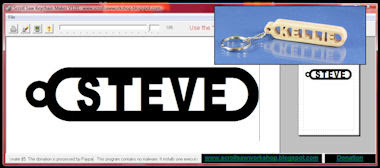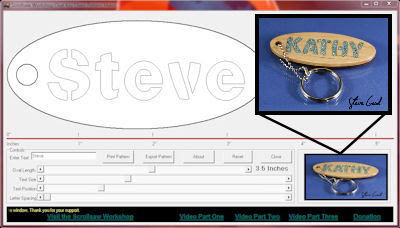Download the Pattern Below

 - -
- -
The Scrollsaw Workshop is primarily supported by donations. If you enjoy this Blog and would like to make a donation please click this Button. Your support is greatly appreciated.
Patty and I both worked a lot of hours before we retired. She was a director at a local hospital and I was an on-call tech. Because of the late hours we got in the habit of eating out a lot. After we retired we still maintained that habit until the pandemic hit. We probably ate out ten plus times a week.
For the last year, we have eaten 99% of our meals at home. We both learned a very good lesson. Fast food makes us sick. Eliminating fast food almost instantly cured problems for both of us. I won't ruin your day with the details. The two or three times we have had fast food delivered in the last year did not go well.
Now I have to admit that I still love a good Wendy's hamburger but it needs to be a treat and not a diet.
I'm sure that some of this is just us getting older but whatever it is I like feeling better more than I like Micky D's. :)
I'm not a very good cook but I am getting better. It's difficult to call what I cook homemade but it is made at home. Our diet still has a lot of flaws with too much sugar and calories but it is improving.
Today's pattern came out of my giving thought to how we have changed our diet. It's difficult for me to say that anything positive has come from the pandemic but the food we eat is one positive for Patty and me.
Scrollsaw Blade Numbering System?
This will not be an in-depth discussion of scroll saw blades. I just want to answer a question that I have received a few times lately. There are a lot of new scroll saw folks out there right now. They got saws for Christmas and are looking for basic information.
Scroll saw blades use a numbering system to designate the size of the blade. #2/0, #1, #3, #5, #7, #9, and #12 are the more common sizes you will see. The smaller the number the smaller the blade.
The sweet spot range for most scroll saw projects is #3, #5, and #7. This will not be true for everyone but as a general rule, these are the blades that will cut most patterns.
Blades that have fewer teeth per inch will cut more aggressively and faster. Blades with more teeth per inch will cut more accurately and slower.
Some people will tell you to choose a blade for a project based on how thick and dense the wood you are cutting is. It is true that the #9 blade will cut 1" thick hard maple more efficiently than a #5 blade. The problem is that you may need a #5 blade to make the cut needed by the pattern. It's always a trade-off between efficiency and accuracy. I choose my blade based on the pattern and the wood.
I'm not going to discuss the different types of blades because it gets so long that everyone stops reading or falls asleep. I'll talk about the types of blades later.
If you are just getting started in the hobby, welcome. I'm happy you found my blog. If you have questions feel free to email me. I'll be honest, I am not able to answer 100% of my email but I do my best. I watch closely for people who are new and have basic questions. The first ten questions are the most important. If you get those answered your experience will be easier. I want to help you get off to a good start.

$12 per sheet of 12 coins plus $3.50 shipping
Inlay with a 1" Forstner Bit.
The perfect way to sign your work.

Email Newsletter Readers: Remember that the Newsletter is just a copy of the daily blog post. To see the post in its proper formatting click this link. If you ever misplace a pattern or any item you see here you can always find it on the blog. Everything stays on the blog forever.
Every Scrollsaw Workshop Pattern from 2007-2020 on DVD
Purchase the entire Scrollsaw Workshop pattern catalog for offline access.
This DVD has over 3,310 patterns published from 2007 thru 2020.
The DVD is $20 plus shipping. Ships to 60 countries around the world.
The DVD is $20 plus shipping. Ships to 60 countries around the world.
If you use the DVD on a Windows PC there is a simple viewer program to browse through the patterns.
The DVD also works fine on a MAC. The viewer program is not MAC compatible but there is an included PDF with all the patterns shown as thumbnails for easy viewing.
All the same file but in an easy to use thumb drive. The USB thumb drive option is $23 plus shipping.
Now Available on USB Thumb Drive
Don't have a DVD drive on your new computer. No problem. Buy the catalog on a USB thumb drive.All the same file but in an easy to use thumb drive. The USB thumb drive option is $23 plus shipping.
My two "Wooden Vases on the Scroll Saw" books make it easy.
The books are $12 each and available for instant download after purchase. Click for Video Demonstration.
My Sponsors:
Support the businesses that support our community.
Home of Pegas scroll saw blades.
for you scroll saw ready boards.
Seyco features the Seyco ST-21 scroll saw
Make sure you check out the Seyco Scrollers Drill
Seyco features the Seyco ST-21 scroll saw
Make sure you check out the Seyco Scrollers Drill
Delta Power Tools 40-694 20 In. Variable Speed Scroll Saw
Still on sale for $327.79 on Amazon.
About this item
- Electronic variable speed can be adjusted from 400-1,750 SPM for a wide array of cutting applications
- Dual parallel link arm design reduces vibration reducing over and under cutting improving accuracy and quality
- Upper arm lifts and locks in the raised position during blade changes or while adjusting blade position for fret work
- Tool-free blade clamp allows for quick, easy blade changes in seconds. Bevels 0° - 45° left and right. Motor: 1.3 Amp
- On/Off switch, electronic variable speed dial, flexible dust blower and blade-tensioning lever are all conveniently located up front on the arm for easy accessibility
- On-tool blade storage area provides neat, organized protection for scroll saw blades, includes 2 straight blades





































